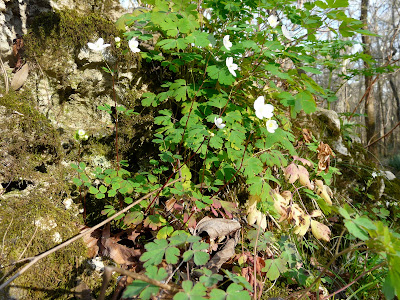Florida's Wild Panhandle: A Photo Essay
The Florida Native Plant Society 2010 Conference is fast approaching. Last month I had the incredible good fortune to to participate in a a scintillating seven-day field trip covering vast portions of Florida’s panhandle, and led by one of the dedicated environmentalists who will be speaking at the conference. That would be Dr. Bruce Means, author of Priceless Florida, who lead our group over, under, around, and INTO longleaf pine forests, remnant hardwood forests, steephead ravines, crystal clear springs, and several kinds of muddy bogs. And let me tell you that neither rain nor snow nor sleet nor hail stopped us. Well, neither rain nor cold anyway!
In fact my enduring memory of this trip will be an image of our intrepid leader, standing just inside some freezing cold, or knee-deep wet, or ridiculously steep place, and waving his arms enthusiastically at us lingerers, while shouting, “Come on, come on! There’s something here I’ve GOT to show you!!”
Using cypress knees as classroom seats in a bog
Climbing heather in bloom
And show us he did. The Appalachian Forest School sponsored this particular trip. The mission of the AFS is to get people into forests so they can first learn about, and then appreciate, the value of these disappearing ecosystems, in the hope that folks will conserve what they value.
How I got on their email list, I'm not sure, but when I first scanned the itinerary
During our trip I was fortunate to see many plants and animals that I had heretofore seen only in books. Like the heather above, and this trillium:
and this green tree frog. Here in south Florida, this little guy has mostly been eaten up by the exotic brown Cuban tree frog.
Also these anemones, and needle palms, not just one, but dozens!
Dr. Means knows the ecology, biology, geology, the flora and fauna and history of Florida from the inside out, and I jumped at the opportunity to spend time learning from him. Although cold weather had retarded the bloom
Like when he dug up and scraped some of the root from this toothache grass,
and said, “Chew it with your front teeth and then spit it out.” The results?
ZING!
Here he is exhorting us to think: "Why are these particular trees here instead of some other kinds? Could this be a virgin stand? Do you think we could see 17 more places before it gets dark?"
Florida’s panhandle, like most of the entire southeastern portion of the United States was once covered in a uniquely productive longleaf pine grassland that supported a vast number of plant and animal species. This beautiful ecosystem, high open pines with a rich herbaceous groundcover, is reduced now to less than 2% of its original domain. We were able to tramp through several remaining examples, prettily enhanced by pouring rain.
Raindrops on dog fennel in longleaf pine forest
Fire was one of the most important elements of this rich system, keeping the hardwood trees out, and enriching the wiregrass with the nutrient-laden ashes afterwards. We got to see a recently burned forest where the pines were standing tall above blackened ground. We learned how the needles and their released steam protected the growing tip of the baby pines and saw violets blooming at their feet.
A violet rises from the ashes
Although this trip was one of kind, you still have the opportunity to experience some of the fun that I did because Dr. Means is going to give a talk during the 2010 FNPS Conference in May.
His presentation is entitled “The Wild Wild World of the Florida Panhandle: Taking Stock of an Amazing Cradle of Life.” You will be amazed the intricate complexity of the plant/animal relationships he discusses, and the unique contribution of the make-up of the land they occupy.
I suggest that you sign up, now! Bruce is not only incredibly knowledgeable, but also a natural teacher, not to mention, are you surprised? - an entertainer.
Sue Dingwell
Post script: If you have been following the new series "Life" on the Discovery Channel, you have seen two of Dr. Means' newest discoveries on the fabulous tapuis of Venezuela: tiny frogs with amazing ways of avoiding predators. He shared with our group the description of how he found these tiny beauties and how he managed to get their unique behaviors recorded on camera....but that is another story!














Comments
Thanks in advance!
https://www.facebook.com/liberella.mumma/media_set?set=a.169591979888758.1073741826.100005138700539&type=3